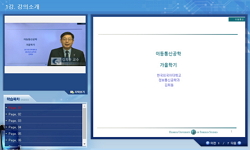다중 반송파 변환(MCM)은 IEEE 802.11a, IEEE 802.16a, HIPERLAN/2와 같이 많은 무선 네트워크 표준의 물리계층에서 사용되어 왔다. 이러한 모든 시스템들은 MCM을 기반으로 한 이산 퓨리에 변환(DFT: Discret...
http://chineseinput.net/에서 pinyin(병음)방식으로 중국어를 변환할 수 있습니다.
변환된 중국어를 복사하여 사용하시면 됩니다.
- 中文 을 입력하시려면 zhongwen을 입력하시고 space를누르시면됩니다.
- 北京 을 입력하시려면 beijing을 입력하시고 space를 누르시면 됩니다.
변형된 DCT를 이용한 OFDM 성능의 향상과 H/W-S/W 검증 = Improvement for Performance of OFDM using the Modified 2-D DCT and H/W-S/W verification
한글로보기https://www.riss.kr/link?id=T11714638
- 저자
-
발행사항
서울 : 건국대학교 대학원, 2009
-
학위논문사항
학위논문(석사) -- 건국대학교 대학원 , 전자·정보통신공학과 전자정보통신전공 , 2009. 8
-
발행연도
2009
-
작성언어
한국어
-
주제어
OFDM ; DCT ; DCT-OFDM ; IEEE 802.11a ; 2D DCT-OFDM
-
발행국(도시)
서울
-
형태사항
vii, 58 p. ; 26cm
-
일반주기명
지도교수:조용범
- 소장기관
-
0
상세조회 -
0
다운로드
부가정보
국문 초록 (Abstract)
다중 반송파 변환(MCM)은 IEEE 802.11a, IEEE 802.16a, HIPERLAN/2와 같이 많은 무선 네트워크 표준의 물리계층에서 사용되어 왔다. 이러한 모든 시스템들은 MCM을 기반으로 한 이산 퓨리에 변환(DFT: Discrete Fourier Transform)의 부류에 속한다. 이러한 시스템들은 직교의 원리로서 복소 지수 함수 모음을 사용한다. 특히 직교 주파수 분할(OFDM) 시스템에 있어서, 디지털 변조와 복조는 각각 역 이산 퓨리에 변환(IDFT)과 이산 퓨리에 변환(DFT)로 구현될 수 있다. 일반적인 BPSK, M-ary PSK, QAM으로부터 생성된 데이터는 변조시 역 이산 퓨리에 변환(IDFT) 또는 IDFT의 빠른 알고리즘인 역 고속 퓨리에 변환(IFFT)이 수행되어 진다. 수신기는 직교의 데이터를 복구시키기 위해서 DFT 또는 DFT의 빠른 알고리즘 구현인 고속 퓨리에 변환(FFT)을 수행한다.
복소 지수 함수 모음은 기저대역 다중 반송파 신호들을 구성하기 위해서 사용되어지는 유일한 직교성의 원리는 아니다. co-sinusoidal 함수의 각각의 모음은 MCM 방식을 실행하기 위한 직교성의 원리로서 사용되어질 수 있다. 그리고 이 방식은 이산 코싸인 변환(DCT)을 사용해서 수행될 수 있다. 특히 quadrature 변조기가 없는 상황에서 BPSK와 펄스 진폭 변조(PAM)와 같은 1차원 변조들(실수를 사용한 변조)의 형식에 대해서 DCT-OFDM은 기존의 DFT를 기반으로 한 OFDM 시스템의 위상잡음과 직교 불균형(IQ) 문제를 완벽하게 피할 수 있다. FFT 알고리즘보다 더 적은 연산량을 제공할 수 있는 다양한 고속 DCT 알고리즘이 제안 되어져 왔다.
JPEG과 MPEG-1/2/4와 같이 정지된 이미지 그리고 영상 코딩 표준에 있어서 DCT와 DCT의 고속 알고리즘은 변형 코딩을 위해 널리 이용되어져 왔다. 최근의 연구들에는 H.264 영상 코딩에 대한 정수 변환을 설계하고 개발하려고 하는 몇몇의 노력이 있었다.
본 논문에서는 OFDM에 시스템 구현에 DFT 구조를 대신하여 fixed 8 × 8 point DCT 구조를 사용하는 것을 제안한다. 또한 버터플라이 구조를 갖는 IDCT/DCT를 사용할 경우, 쉬프터와 덧셈 연산으로 구현이 가능하여 더 적은 로직으로 구현이 가능하다. 고정 소수점 산술연사 로직의 사용은 근사치 오류(Approximation error)를 발생 시킨다. 이러한 근사치 오류는 DCT 기반의 OFDM 시스템의 구현시에 직교성의 손실을 유발한다. 그러므로 우리는 곱셈 매게 변수들의 근사치 오류를 감소시키기 위해서 DCT의 계수를 조절한다. 구현된 설계는 복잡도를 상당히 감소시켰고 그 결과 게이트 수와 전력 소비를 감소 시켰다. 구현은 Virtex 2 FPGA의 DSP-plus 5000 Libertron Board에서 구현하였다. 2D IDCT-DCT를 기반으로 하여 복잡도를 감소시킨 OFDM의 구현 결과는 기존의 DFT-OFDM 시스템에 비하여 우수한 BER 성능을 보이는 것을 확인 하였다. 완성되어진 결과물로 미래의 표준에 있어서 2D IDCT-DCT OFDM의 사용을 기대해 본다.
다국어 초록 (Multilingual Abstract)
MULTICARRIER modulation(MCM) is used in the physical layers of many wireless network standards, such as IEEE 802.11a, IEEE 802.16a, and HIPERLAN/2. All of these systems belong to the class of discrete Fourier transform(DFT)-based MCMs. They employ the...
MULTICARRIER modulation(MCM) is used in the physical layers of many wireless network standards, such as IEEE 802.11a, IEEE 802.16a, and HIPERLAN/2. All of these systems belong to the class of discrete Fourier transform(DFT)-based MCMs. They employ the complex exponential functions set as orthogonal basis. Particularly, in orthogonal frequency-division multiplexing(OFDM) systems, digital modulations and demodulations can be realized with the inverse DFT(IDFT) and DFT, respectively. Data obtained from general signaling (Binary Phase-Shift Keying(BPSK), M-ary PSK, and M-ary quadrature amplitude modulation(QAM), etc.) are first processed by an IDFT, or its fast algorithm, the inverse fast Fourier transform(IFFT); then the resulting complex samples are transmitted by in-phase and quadrature modulators. The receiver performs a DFT, or its fast algorithm implementation, fast Fourier transform(FFT), to restore the original data.
However, the complex exponential functions set are not the only orthogonal basis that can be used to construct baseband multicarrier signals. A single set of co-sinusoidal functions can be used as an orthogonal basis to implement the MCM scheme, and this scheme can be synthesized using a discrete cosine transform(DCT). Particularly, for one-dimensional(1-D) modulations (Real-valued modulation formats), such as BPSK and pulse amplitude modulation(PAM), in the absence of a quadrature modulator, DCT-OFDM can completely avoid the in-phase/quadrature-phase(IQ) imbalance problem inherent in conventional DFT-based OFDM systems. Various fast DCT algorithms have been proposed which can provide fewer computational steps than FFT algorithms.
Within still-image and video coding standards, such as JPEG and MPEG-1/2/4, the DCT and its fast algorithm designs have been widely utilized for transformation coding. During the current researches, there exist several explorers to design and develop the integer transforms for H.264 video coding. Combining with integer transform and quantization designs in H.264, the integer DCT can be computed without multiplications, just additions and shifts.
In this paper we propose the use of fixed 8 × 8 point DCT structure in OFDM. The modifications in butterfly structure enable the use of shift and add operations which can be implemented with fewer logic. The use of fixed point arithmetic logic introduces some approximation error. This approximation error makes the IDCT design non-orthogonal which is the basic requirement of OFDM system. Hence, we adjust the multiplication parameters to reduce the approximation error. The complexity has been significantly reduced to reduce the gate count and power consumption. The implementation was carried out on DSP-plus 5000 Libertron Board comprising of Virtex 2 FPGA. The implementation results that reduced complexity OFDM performs better than the conventional system. With the achieved results we can expect the use of 2D IDCT-DCT OFDM in future standards.
목차 (Table of Contents)
- 제1장 서론 = 1
- 1.1. 연구의 배경 = 1
- 제2장 OFDM = 3
- 2.1. OFDM의 기본개념 = 3
- 2.2. OFDM의 기본원리 = 7
- 제1장 서론 = 1
- 1.1. 연구의 배경 = 1
- 제2장 OFDM = 3
- 2.1. OFDM의 기본개념 = 3
- 2.2. OFDM의 기본원리 = 7
- 2.2.1. 직교성 = 7
- 2.2.2. OFDM 변조 = 10
- 2.2.3. OFDM 복조 = 12
- 2.2.4. OFDM 통신시스템 = 13
- 제3장 제안하는 2D IDCT-DCT 구조 = 16
- 3.1. DCT 기본개념 = 16
- 3.2. FFT와 DCT의 직교성 = 17
- 3.2.1. FFT 수식 = 17
- 3.2.2. DCT 수식 = 18
- 3.3. 제안하는 2D IDCT-DCT 알고리즘과 구조 = 19
- 제4장 2D IDCT-DCT의 H/W 설계 및 검증 = 26
- 4.1. 설계방법 = 26
- 4.2. IDCT 설계 및 검증 = 27
- 4.3. DCT 설계 및 검증 = 33
- 제5장 구현 및 실험결과 = 39
- 5.1. 검증장비 = 39
- 5.1.1. Mathwork (Matlab/simulink)의 기능 = 39
- 5.1.2. Libertron (Dsp Plus 5000)의 기능 = 39
- 5.2. 검증환경 = 40
- 5.3. OFDM (Matlab/Simulink) 시뮬레이션 = 41
- 5.4. OFDM(Matlab/Simulink) & H/W 코시뮬레이션 = 44
- 5.4.1. OFDM(Matlab/Simulink) 모델과 RTL Code의 연동 = 44
- 5.4.2. RTL 코시뮬레이션 = 45
- 5.4.3. H/W 코시뮬레이션 = 48
- 5.4.4. 결과 값 비교 = 49
- 제6장 결론 = 53
- 참고문헌 = 55
- ABSTRACT = 57










